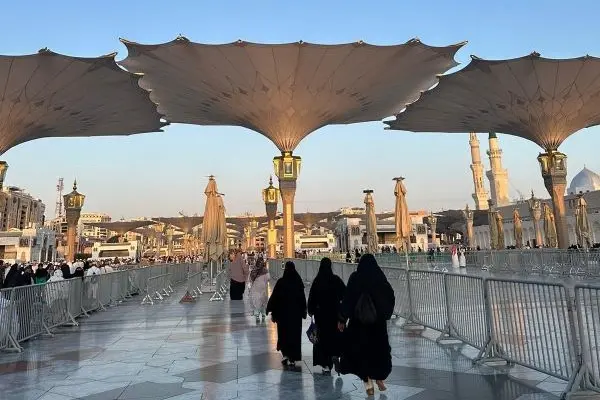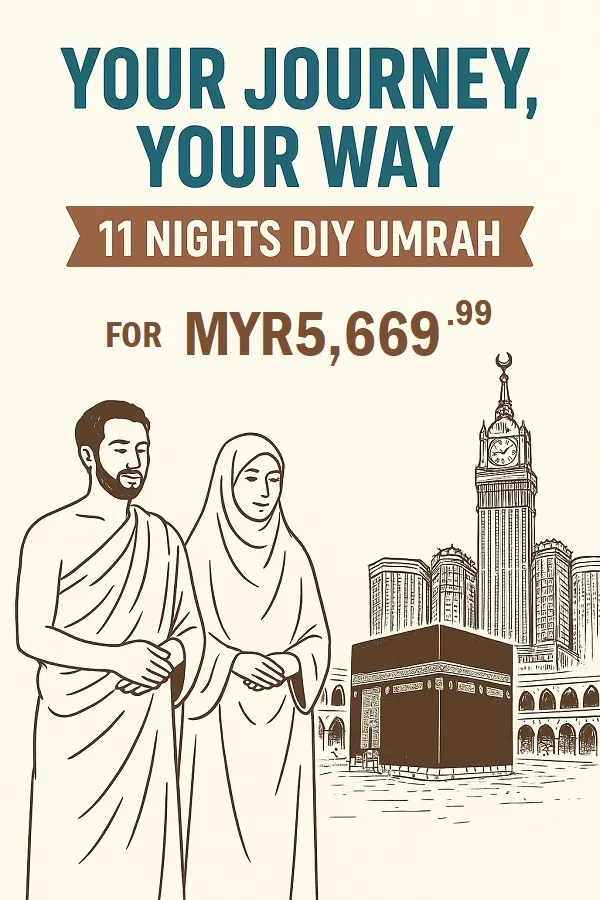Alhamdulillah
My daughter and son-in-law recently returned from their DIY Umrah journey and met her father-in-law and mother in Makkah. Upon their return, I was showered with thoughtful gifts—an embroidered sejadah with my name, Ajwa dates from her mother-in-law, a beautiful jubah from my daughter, and perfume from my son-in-law. Each gift reminded me of the sacred land and deepened my longing to be called back to the holy cities. InsyaAllah, may Allah bless me with another opportunity to visit soon.
This blog is a little introduction to their journey, hoping to share a few experiences that might be useful for future pilgrims planning their Umrah.
Cancellation of Flight: A Lesson in Planning
About a week before their departure to Jeddah, they received unexpected news. Batik Air had canceled their return flight from Madinah to Kuala Lumpur. In a rush, they booked tickets with Qatar Airways, only informing me after the fact. I immediately suggested they check Saudia Airlines, which was offering a 50% discount. After checking, they found out that the Saudia tickets were indeed much cheaper. They were ready to change their plans but realized the cancellation fee with Qatar Airways, was USD 200 per ticket—too costly to justify switching.
When I asked why they hadn’t checked my blog or DIY Umrah Facebook page, where I had posted about the Saudia promotion, my son-in-law told me they were too busy packing for their departure from Melbourne.
Lesson learned: When preparing for a trip as significant as Umrah, staying updated on travel promotions and flight changes is essential. Checking relevant information, even last-minute, can save you a lot of money.
Experiences Shared Upon Their Return
1. The Camel with Tears
One evening, just before Maghrib, my daughter and son-in-law visited the Cave of Hira. On their way up, my daughter noticed a friendly camel and was tempted to ride it, but since it was almost time for Maghrib prayer, she decided to continue her walk. Upon reaching the cave, they saw behaviors that should be avoided—like wiping and kissing the stones for blessings. My daughter felt uneasy witnessing such actions, as they go against the teachings of Islam.
Cave of Hira, Makkah
After offering their Maghrib prayer, they descended the hill and encountered the same camel. By then, it was nighttime, so she chose not to ride but instead spent some time caressing and talking to the camel. To her surprise, the camel responded with a sound, followed by tears streaming from its eyes. She felt a deep sadness, believing the camel was exhausted and possibly mistreated. This reminded her of the hadith on the mistreatment of camels, where the Prophet Muhammad (SAW) admonished people for overburdening animals.
The Prophet (SAW) once saw a camel with sunken eyes and a thin body. He said: ‘Fear Allah regarding these mute animals. Ride them in a state that is appropriate and eat them in a state that is appropriate.’ (Sunan Abi Dawood 2548)
Camel in Tears, Cave of Hira, Makkah
2. Entering Jannatul Baqi
While my daughter was focused on the spiritual aspects of her journey, my son-in-law was more curious to explore different experiences. One of his goals was to visit Jannatul Baqi, the sacred cemetery in Madinah where many of the Prophets companions and family members are buried.
Though it’s generally not possible to enter Jannatul Baqi unless you’re part of a funeral procession, my son-in-law recalled advice from his Imam in Melbourne. He mentioned that if one follows the funeral procession after Fajr or Asr prayers, they might be able to enter the cemetery. Performing funeral rites is a highly rewarding deed in Islam, and by assisting in carrying the body, one gains even more blessings.
So, after Fajr prayer, he positioned himself near solat areas 34 to 37, where funeral processions typically begin. He followed the jenazah (funeral procession) to the entrance, assisting in carrying the body to its resting place inside Jannatul Baqi. This allowed him to visit the cemetery more closely, rather than viewing it from behind the fences.
Jannatul Baqi, Madinah
3. Encounters with Locals
Unfortunately, my daughter and son-in-law also encountered some frustrating moments. Whether it was metered taxi drivers or fast-food cashiers, they experienced situations where they felt overcharged. In some cases, drivers did not use the meter, and even in the Holy Lands, some workers took advantage of pilgrims by charging them extra.
These experiences serve as a reminder that even in the most sacred places, it’s essential to remain vigilant and aware of your surroundings. Always confirm prices and insist on using metered taxis to avoid any unnecessary stress.
Conclusion
As I reflect on my daughter's journey, I am reminded of how enriching and spiritual Umrah can be. Despite the challenges they faced, their experiences are full of lessons, both practical and spiritual. Their story has reignited my longing for Makkah and Madinah, and I pray that Allah grants all of us the chance to return to these sacred lands.
For those planning your own DIY Umrah, take time to research, stay informed, and prepare yourself both mentally and spiritually. May your journey be smooth, and may you find peace and blessings in every step.
Affiliate Disclaimer: Some of the links in this guide are affiliate links, meaning, at no additional cost to you, we may earn a commission if you click through and make a purchase.
Sertai komuniti kami melalui Newsletter.
Terima Kasih
Terima Kasih









